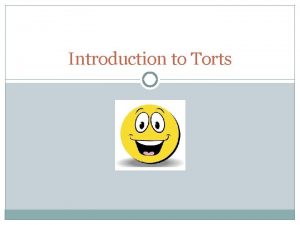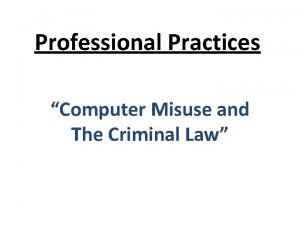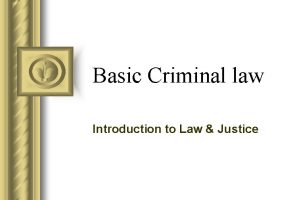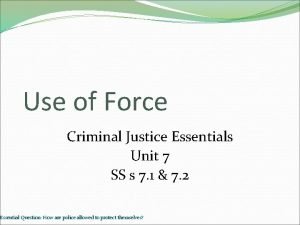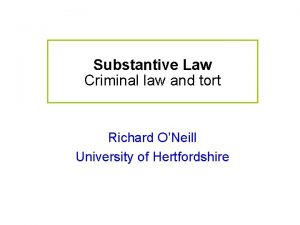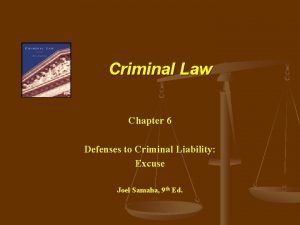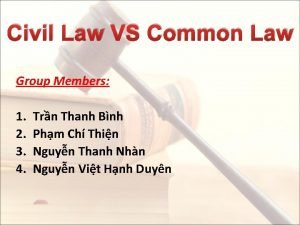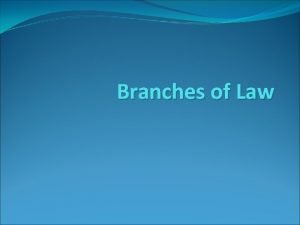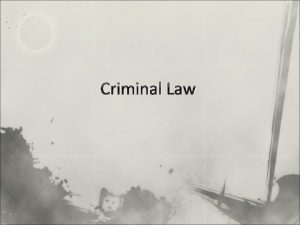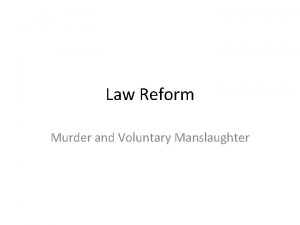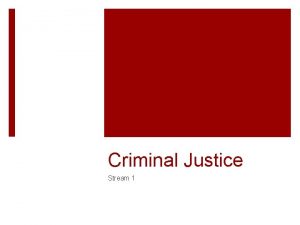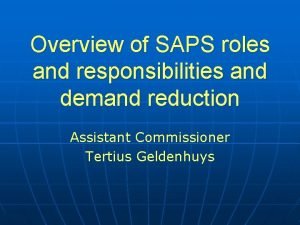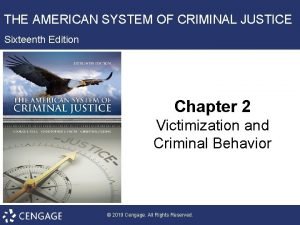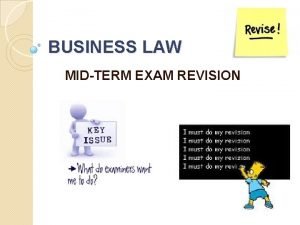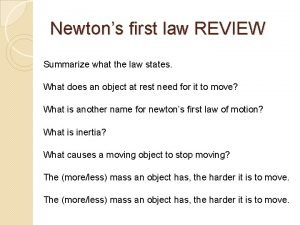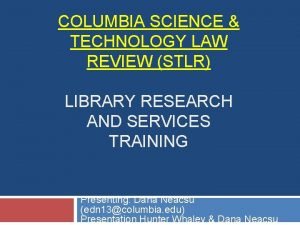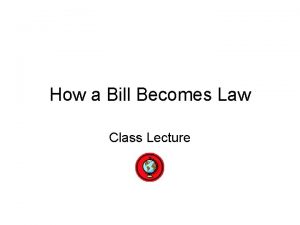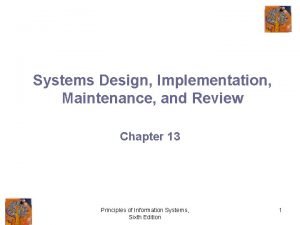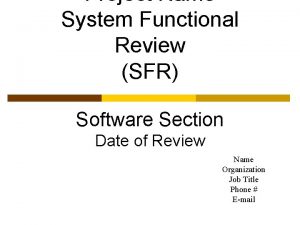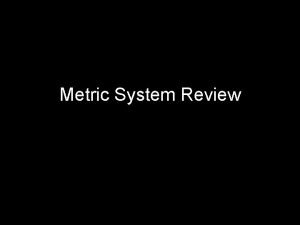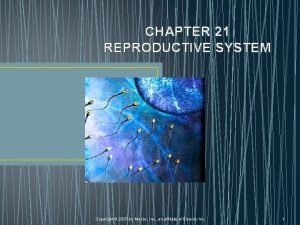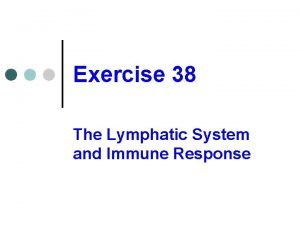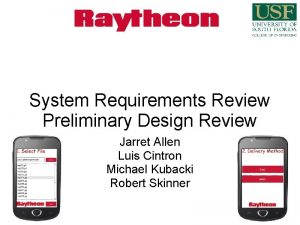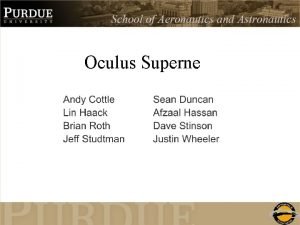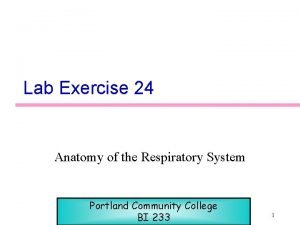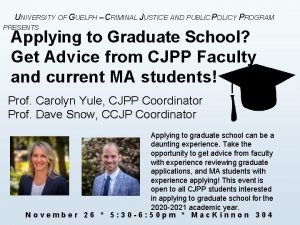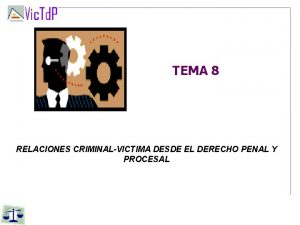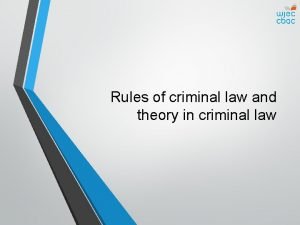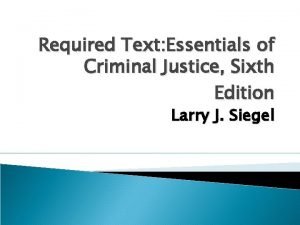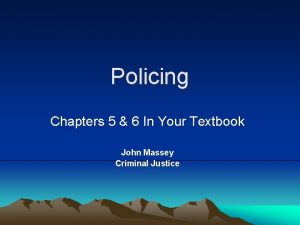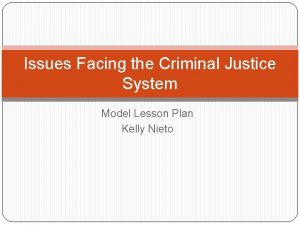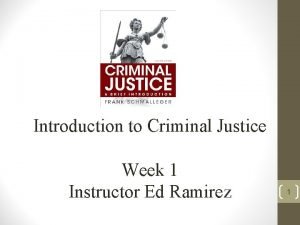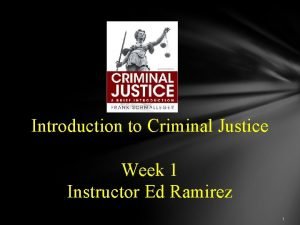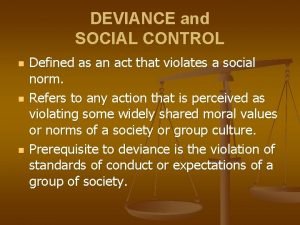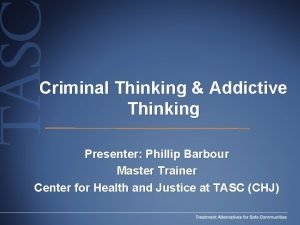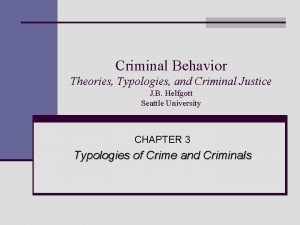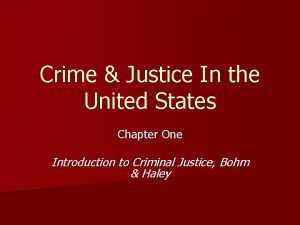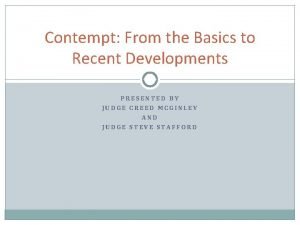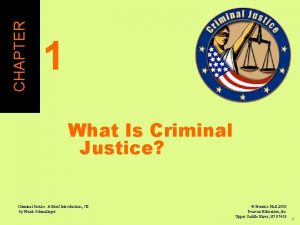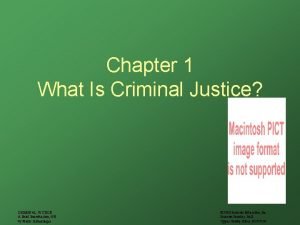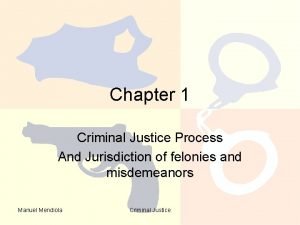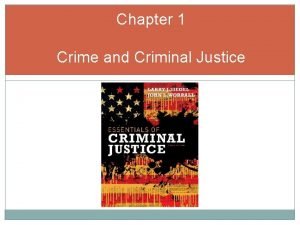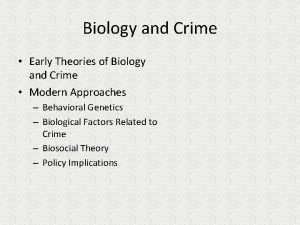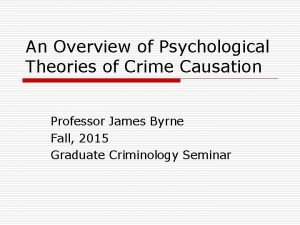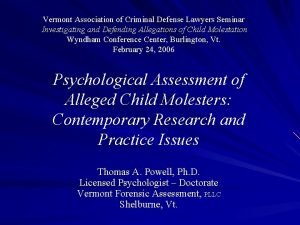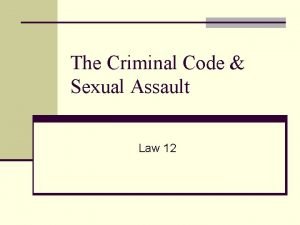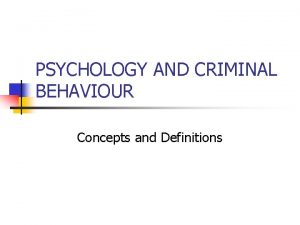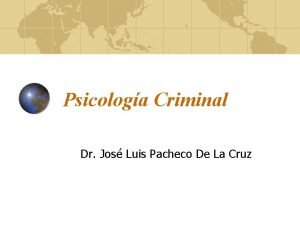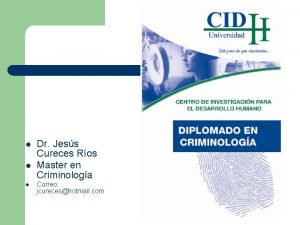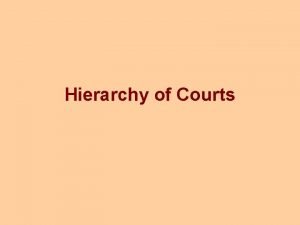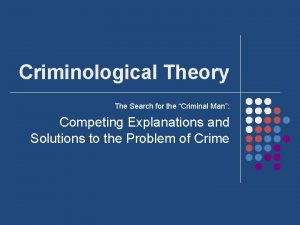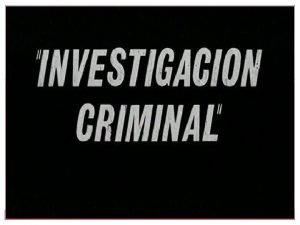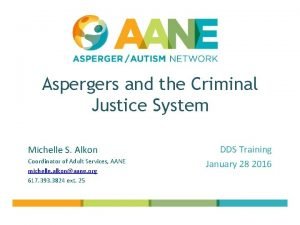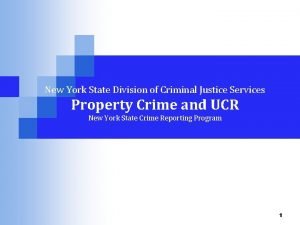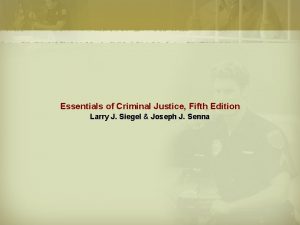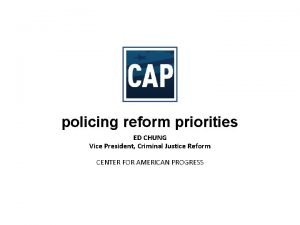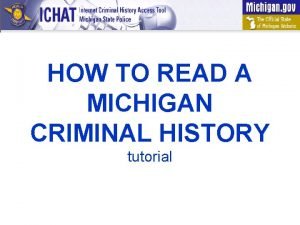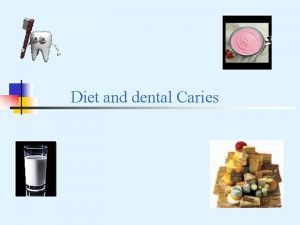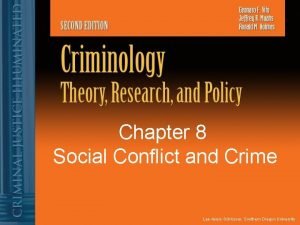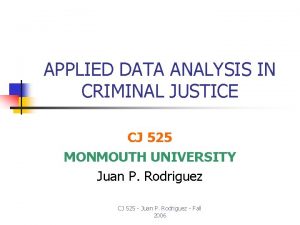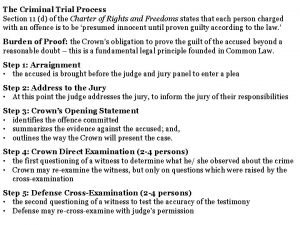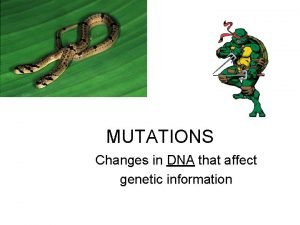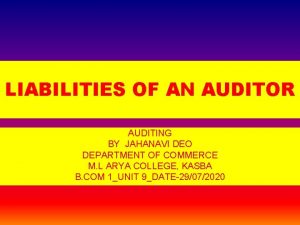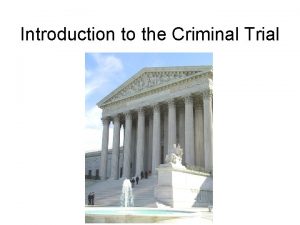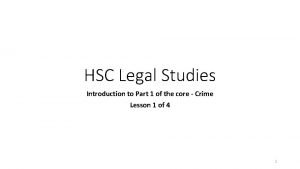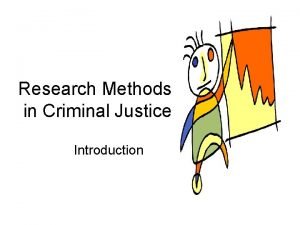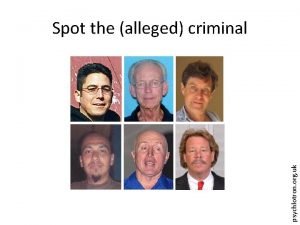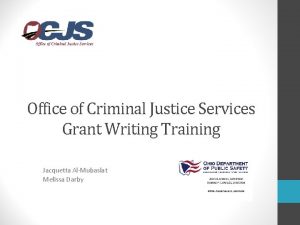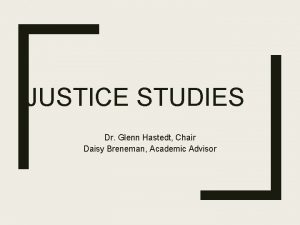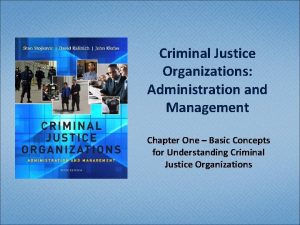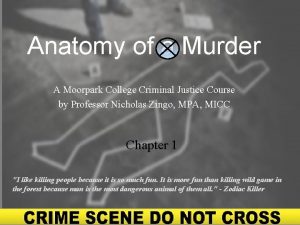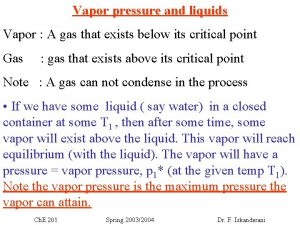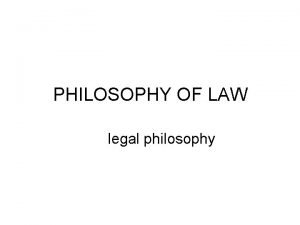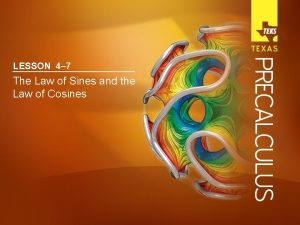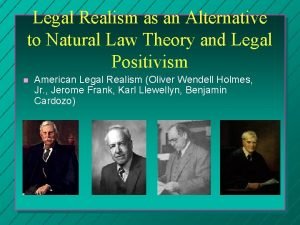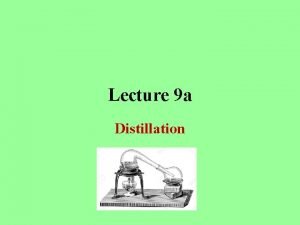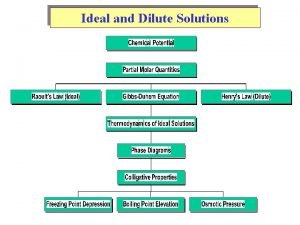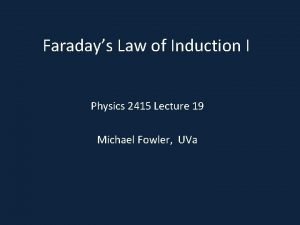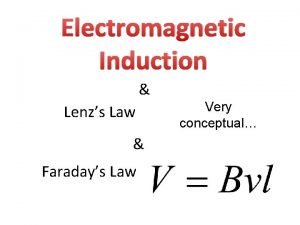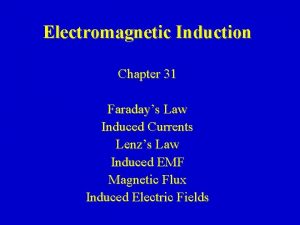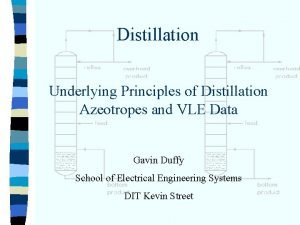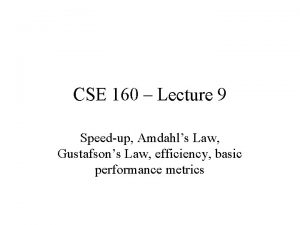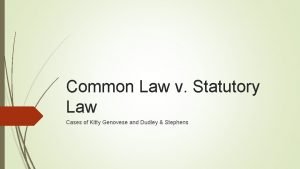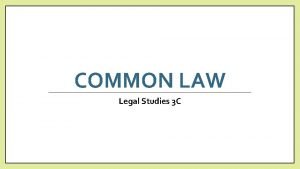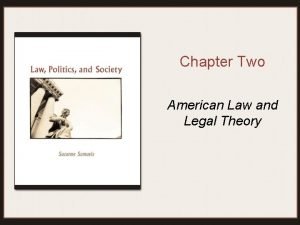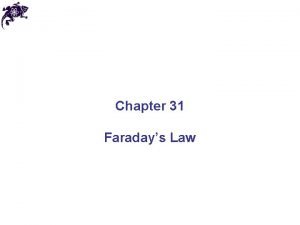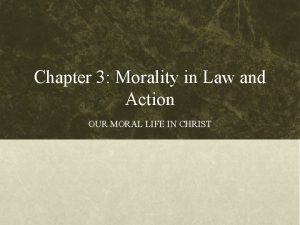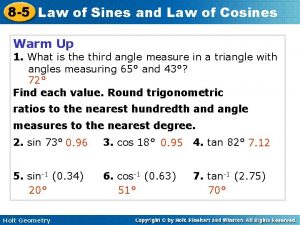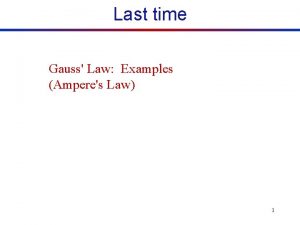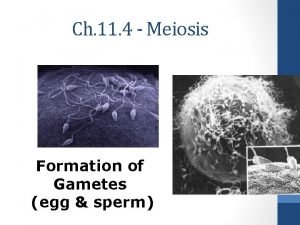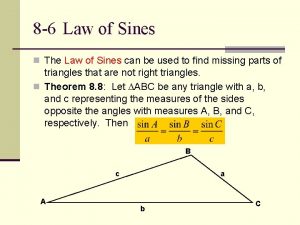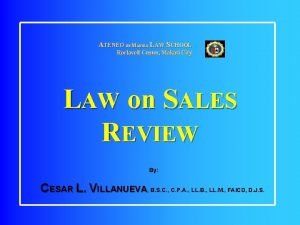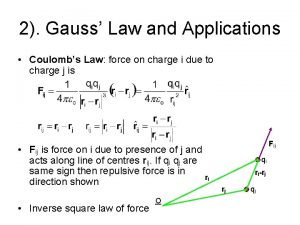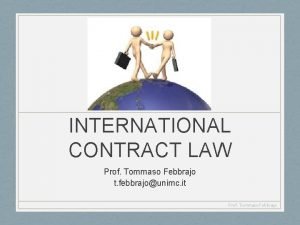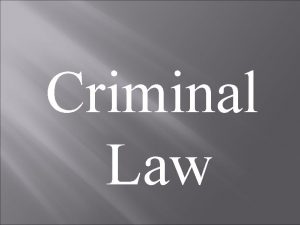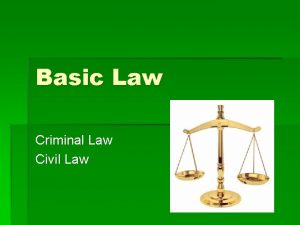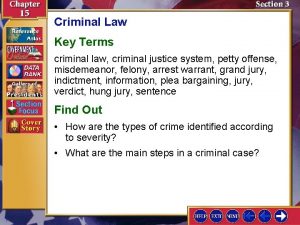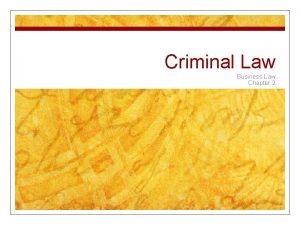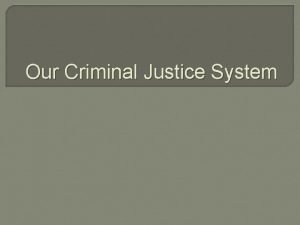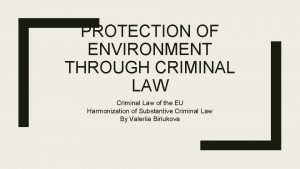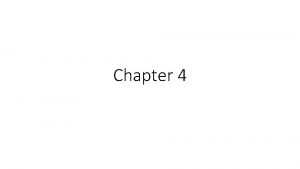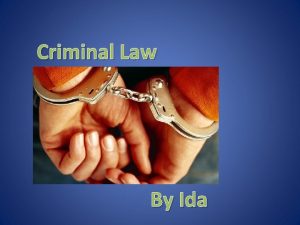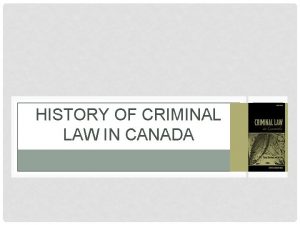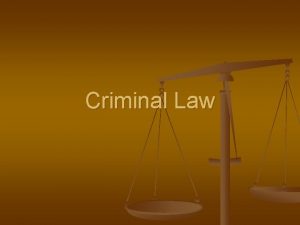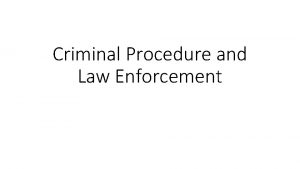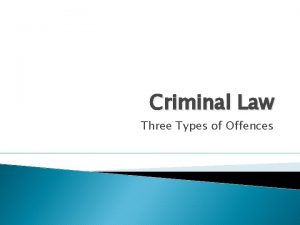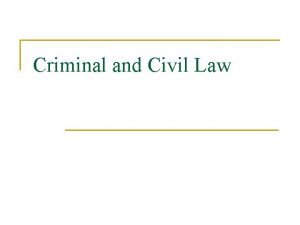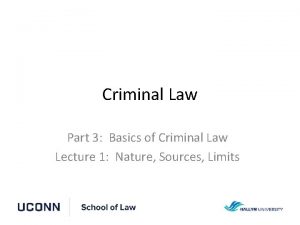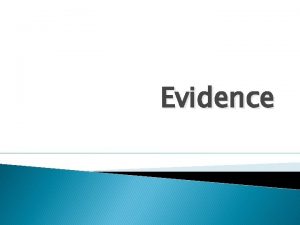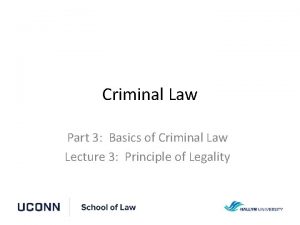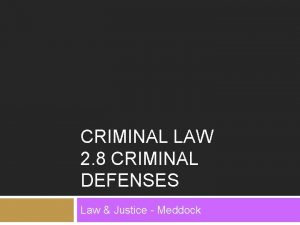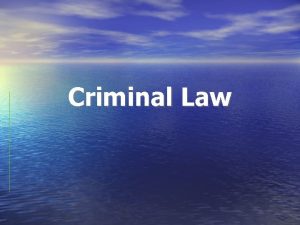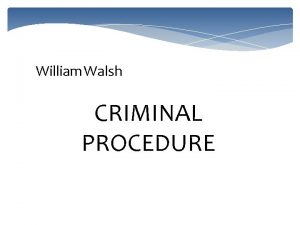Criminal Law Review Criminal law is a system



































































































































































- Slides: 163

Criminal Law

Review • Criminal law is a system that tries to balance the rights of society to be protected against the civil rights of the individual by the law • A crime is a wrong against society • The main purpose of criminal law is to protect society and maintain the peace

The Criminal Law System

Purposes of Mainstream Canadian Criminal Law • maintain order • protect society • punish the guilty • prevent further crime

Review: Alternative Justice Systems • Traditional Aboriginal views of criminal law are significantly different from the mainstream Canadian legal system • Theirs is a restorative, rather than a punitive process • Within this system it is the action of the person that is bad, and not the person • Those who offend are viewed as requiring healing • Purposes include: • healing the person who has committed the offence • healing the relationship between the "victim" and the person who has committed the offence, and the whole community

Grounds for Action • Being accused of a crime can damage a person's reputation in the community and cause personal suffering • For this reason, the police cannot arrest a person unless there is good reason to believe that the person has committed a crime • This doesn't however, require absolute proof • Whether or not a crime has been committed will be decided in the trial

Action • The law recognizes that some crimes (such as murder) are a greater risk to society than others (such as shoplifting) • For this reason, there are three different procedures for making certain people appear at their trial • A person being charged with a less serious offence will usually be given a summons or an appearance notice that describes the charge and tells the accused person when and where to appear in court • A person accused of a more serious offence will be arrested • The Criminal Code describes every aspect of police action, from how evidence may be obtained to the actual forms that should be used • These procedures limit police power to that which is necessary to keep the public safe

Burden of Proof • In a criminal trial, the accused is presumed to be innocent; it is up to the Crown to prove that the accused committed a crime

Degree of Proof • The degree of proof in a criminal case must be beyond a reasonable doubt • Example: You come into the kitchen to find the once full milk jug broken on the floor, but no spilt milk. Your cat is sleeping peacefully on the windowsill. Unless you have convincing evidence, such as milk on her whiskers, a witness to the crime, or paw prints on the milk jug, a judge and jury might say there is a possibility that your cat is innocent and some stray feline did the deed. Your cat's defense lawyer does not have to prove that the cat is innocent, only that the cat might be innocent • It can be quite difficult to be certain that there is no doubt that the accused person committed a crime

Did Mrs. Whiskers Do It? • If the cat in the story was on trial, and you were the defense lawyer, what would you have to do to defend your client? • Identify and briefly discuss at least four reasons why your cat may be innocent

Findings • The findings are what a judge concludes after considering: • the details of the crime • statutes and case law • the rights of the accused • the best interests of society • current social attitudes to this type of crime • the verdict of the jury (if there is one)

Findings • As a minimum, findings will include: • A verdict of guilty and a sentence • A verdict of not guilty, an acquittal, and no criminal record • When it comes to sentencing, a judge aims to select a punishment that fits the crime • The law provides guidelines for penalties, but there is still room for interpretation • If a sentence is seen as too severe, the defense counsel may appeal the decision to a higher court • If the sentence is seen as too lenient, the Crown may appeal

Elements of a Crime • For a crime to occur, two elements must be present: • The physical element (actus reus) • The mental element (mens rea) • Additionally, there are six things that must be covered when defining a crime: 1. 2. 3. 4. 5. 6. the description of the wrongful act (actus reus) the state of mind accompanying the act (mens rea) a definition of key terms the defences to the offence the type of the offence the maximum punishment for anyone found guilty of committing the offence

Elements of a Crime • In our society we tend to feel that it is not right to punish someone for doing something, unless that person meant to do it or intended to do it • This is reflected in the criminal law, as before anyone can be convicted of a crime, the Crown must show not only 1) that the prohibited act was done, but 2) that the "guilty mind" was there as well

Actus Reus • This is a Latin term that roughly means, "prohibited act. " • All of the "prohibited acts" are set out in the Criminal Code (or other federal act) • The Crown must prove that the particular action listed in the legislation occurred and that the accused is the one who did it • Example: There is a section of the Criminal Code that makes it an indictable offence to discharge a firearm with the intent to wound any person. Mr. Weaver was hunting and was chased by a farmer's dog. . . then shot the dog in self defence. He was charged under the offense above. Was he guilty? Explain.

Answer • The provincial court judge dismissed the complaint as not stating an offence; there was no actus reus known in law (R. v. Weaver, Ontario, 1981). " The actus reus was discharging a firearm with intent to wound a person, not a dog. Mr. Weaver did not commit that actus reus.

Mens Rea • A rough translation of this Latin phrase would be "guilty mind", and generally, mens rea means intention • The Crown must prove this element before anyone can be convicted of a crime • If you desired certain consequences to follow your act, you have mens rea • Example: You are walking along the street and the hooked handle of your umbrella accidentally catches on someone's purse and pulls it away from them 1. Have you committed actus reus? Explain. 2. Have you committed mens rea? Explain.

Mens Rea • You have likely committed the actus reus of theft (by depriving someone of their right in property) but you did not have the mens rea, or the intention to do so. It was an accident.

Negligence • Mens rea can also be satisfied by recklessness or criminal negligence • If you act in a way that may cause harm, and you are reckless about whether it does or not, and you deliberately choose to keep acting that way, you may be found to have the necessary mens rea for conviction • Generally, the actus reus and the mens rea must occur at the same time • Example: "If a person killed another person by accident, but later admitted to being glad that the victim was dead, the killing remains an accident, not murder. "

Review 1. 2. 3. 4. Define actus reus Define mens rea. Which area of law is responsible for criminal law? A young person wants to purchase some drugs and spends his money on a substance he believes to be cocaine. It turns out to be icing sugar. Is this an offence?

KEY 1. Actus reus is a Latin phrase meaning "a wrongful action. " 2. Mens rea is a Latin phrase meaning "a guilty mind. " 3. The federal government is responsible for criminal law. 4. There is no act us reus present. Purchasing icing sugar is not against the law.

Criminal and Quasi-Criminal Offences • While the federal government has jurisdiction (the power to pass and enforce laws) over criminal offences, the provincial government has jurisdiction over some areas, such as: • Some motor vehicle laws • Laws regarding alcohol • These laws appear in provincial statutes, not in federal statutes • There is a difference between criminal offences and quasi criminal offences

Examples 1. Federal government—deals with issues such as gun control and murder 2. Provincial government—deals with speed limits, impaired driving limits, and issues involving schools 3. Municipal government—deals with things such as smoking in public places and zoning laws 4. First Nations—Under the recommendations of the Aboriginal Justice Implementation Commission, First Nations and Metis communities would have legal systems parallel to those of all three levels. At this time, these recommendations have not been implemented. 5. Laws passed by the provinces or municipalities are not considered part of criminal law but rather are referred to as quasi-criminal law.

Defenses to Criminal Charges

Defenses to Criminal Charges • The Criminal Code sets out which defences apply to particular crimes • An accused person has a defence to a criminal charge when there is a reason why he or she should not be held responsible for the crime • When a person pleads "not guilty" to a criminal charge, he or she is saying that there is a defence against the Crown's allegations • There a total of 10 specific defences that can be used

Presumption of Innocence • This is the simplest and most common defence is built into every criminal trial • A person cannot be held responsible for a crime unless the Crown proves, beyond a reasonable doubt, that the accused did everything he or she is accused of • The accused does not specifically have to deny anything; when they say "not guilty" they are presumed to have denied everything in the charge • The accused could sit through the whole trial without bringing any witnesses and without cross examining anyone and still be acquitted • Sometimes, however, reasonable doubt requires the defense to raise a doubt • Usually this means cross examining the Crown's witnesses, calling witnesses for the defence, and occasionally, the accused will give evidence • Almost always, the defence will present a story that is consistent with the accused's innocence • If the judge or jury has a reasonable doubt that, given both the prosecution's and defence's evidence, the accused might be innocent, the accused must be acquitted

Defense and Actus Reus • The Crown must prove each essential element of the crime • Sometimes, instead of denying the charge generally, the accused might try to prove certain facts that will raise a doubt about one particular element • Most of these defences concern the mental element of the crime, although one, the defence of alibi, means that the accused denies that he or she was even at the scene of the crime and therefore could not have done the actus reus

Defense and Mens Rea • Specific defences that involve denying that the accused had the mens rea include: • was too drunk to know what he was doing • The accused was in a sleepwalking like condition at the time • The accused mistakenly thought he was doing something which would have been perfectly legal if he had been doing it

General Defenses • All the defences that involve denying that the accused committed the elements of the offence are called general defences

Special Defenses (Group 1) • Some defences, on the other hand, are like excuses • The accused admits to doing the act and intending to do it, but claims that there are special facts that should prevent her from being held responsible • The first group of these asserts that, although the accused did what was done, she was justified in doing so—that under the circumstances she was within her rights • Self defence • defence of property • compulsion by threats or force of circumstances are examples of this kind of defence

Special Defenses (Group 2) • This group of special defences exists because of public policy

Example: • if a person is persuaded by a police officer to commit a crime he would not otherwise commit, even if that person commits the crime with the necessary intention, he might be acquitted. The police are hired to prevent crime, not to encourage it. Therefore, they are discouraged from inciting people to commit crimes by courts refusing to convict people who are trapped by this sneaky method. Normally it is no defence to claim that someone talked you into committing the crime; this only means that the other person was a party to the offence by counselling. If the counsellor is a police officer, however, this defence, called the defence of entrapment, might apply. The defence of entrapment is well established in American courts, but it is not so certain in Canada.

Defenses to Criminal Charges

Insanity • An accused found to be insane must be acquitted as the accused lacked the necessary mental capacity to commit a crime • This defence goes to negate the accused's mens rea and is defined in the Criminal Code, section 16

Section 16 (1) No person shall be convicted of an offence in respect of an act or omission on his part while that person was insane. (2) For the purposes of this section, a person is insane when the person is in a state of natural imbecility or has disease of the mind to an extent that renders the person incapable of appreciating the nature and quality of an act or omission or of knowing that an act or omission is wrong. (3) A person who has specific delusions, but is in other respects sane, shall not be acquitted on the ground of insanity unless the delusions caused that person to believe in the existence of a state of things that, if it existed, would have justified or excused the act or omission of that person. (4) Every one shall, until the contrary is proved, be presumed to be and to have been sane. R. S. , c. C 34, s. 16.

Insanity • If insanity is to operate as a defence to a criminal charge, it must be such as to render the accused incapable of understanding the nature and quality of his or her act, or from knowing that the act is wrong • If the accused raises the defence of insanity, it need not be proved beyond a reasonable doubt, but only on a balance of probabilities • If it is established, the accused is not set free, but is committed to a psychiatric hospital for an indeterminate period of time and is released only when sanity is recovered and the Lieutenant Governor of the province signs a release order • The Supreme Court of Canada has held that it is up to the judge or jury to ultimately decide whether or not that condition amounts to legal insanity

Automatism "Automatism is a term used to describe unconscious, involuntary behaviour, the state of a person who, though capable of action, is not conscious of what he is doing. It means an unconscious, involuntary act where the mind does not go with what is being done" (Supreme Court of Canada, 1980)

Automatism • If for some reason a person's physical movements are not subject to the control of the mind, there is no voluntary action by that person and therefore no actus reus of any offence • If, however, the causes of the automatic acts, or the automatism, result from something internal, such as a disease of the mind caused by tumours or venereal disease, the person is suffering from insane automatism, and if found not guilty for that reason would be confined to a psychiatric institution • A successful defence of non insane automatism, however, would result in the accused being acquitted and set free, as there would be no reason to suspect that the person had not recovered from the trauma that caused the automatism • Conditions that have been accepted as causing a state of automatism include: • • Sleepwalking carbon monoxide poisoning a physical blow a stroke

Drunkenness • This is only a partial defense, and may not be used to excuse an accused who voluntarily got into the intoxicated state and committed an offence for which no specific intent is required • Some crimes require specific intent, others require general intent • This defense will not work in the case of general intent • Public policy is very much against people being excused because of drunkenness, and the Criminal Code states very specifically the degree of intent required

Example • If the Crown is trying to establish assault with intent to steal (section 343 [c]), this defence has been used to say that perhaps the accused was too drunk to have been able to form the necessary intent to commit the crime • However, the crime of simple assault requires only a general intent—to apply force—and drunkenness cannot negate general intent • In an example such as this, the charge could be reduced to assault if drunkenness was successfully established • Often the defence of drunkenness is used to reduce murder to manslaughter • Murder requires proof that the accused meant to cause death or bodily harm • If the accused was too impaired by alcohol or a drug to have formed this intent, a conviction for manslaughter may result, as it does not require the specific intention to cause harm

Duress • The defence of duress or compulsion is set out in the Code at section 17. A person who commits an offence under compulsion by threats of immediate death or bodily harm from a person who is present when the offence is committed is excused for committing the offence if the person believes that the threats will be carried out and if the person is not a party to a conspiracy or association whereby the person is subject to compulsion, but this section does not apply where the offence that is committed is high treason or treason, murder, piracy, attempted murder, sexual assault with a weapon, threats to a third party or causing bodily harm, aggravated sexual assault, forcible abduction, hostage taking, robbery, assault with a weapon or causing bodily harm, aggravated assault, unlawfully causing bodily harm, arson or an offence under sections 280 to 283 (abduction and detention of young persons). R. S. , c. C 34, s. 17; 1974 75 76, c. 105, s. 4.

What The Heck Does That Mean? • If this defence is successful, you may still be found to have committed all of the necessary elements of an offence, but you are "excused" from responsibility for it • The threats must be of violence against a person; a threat against property is not sufficient to raise this excuse • The threats must be immediate; it is not good enough to say that bodily harm may have occurred at some later date • This defence is not available for a list of very violent crimes • This defense may provide an excuse for the actual commission of a crime, but it does not speak of excusing those who are parties to an offence

Necessity • Compulsion by force of circumstances is a form of the Common Law defence of necessity • It is a rarely used, and a difficult one to establish. • The Supreme Court of Canada has said that it only applies in circumstances of imminent risk where the criminal action was taken to avoid a direct and immediate peril

Example • A family is stranded by the side of a highway during a winter blizzard. It is dark and their car will not start. They leave their vehicle and walk to a nearby farmhouse. Finding nobody home, they break into the house in order to save their lives. If there was no other alternative available to you, you may raise the defence of necessity to a charge of breaking and entering the house.

Entrapment • Entrapment basically involves the police persuading, harassing, or bribing a person to commit a crime, and then arresting the person for that offence • This is a new defense to Canada coming out of Charter challenges • The circumstances must be very clear and show that the accused was entrapped by a police scheme that was so outrageous and shocking as to bring the administration of justice into disrepute • In such a circumstance courts will dismiss the proceedings against the accused as an abuse of process, rather than acquitting the accused of the charge

Mistake • This is a common law defence which recognizes that, if the mistake was an honest and reasonable belief in a certain set of facts, which, if they were true, would have made the accused's act an innocent one

Example • You honestly but mistakenly believe that your spouse is dead and remarry someone else. Your spouse then turns up alive a month later and you are charged with the crime of bigamy (being married to more than one person at a time). You can be acquitted of this charge because of your mistake or ignorance of the facts. • It is only mistake or ignorance of the facts which is a defence, not mistake or ignorance of the law

Alibi • Alibi is a specific defence that may be raised in a general denial of the offence • It means elsewhere, and when you raise it you are saying you were somewhere else at the time the offence was committed • You need not prove your alibi beyond a reasonable doubt; you merely have to raise a doubt in the Crown's case • In most cases credibility (believability) will be important in this type of defence • It should be raised as soon as possible, not for the first time at the trial, as the judge or jury may regard that as suspicious

Self-Defence • The Criminal Code does allow you to use force to protect yourself, your property, or anyone under your protection, but the amount of force used must be "reasonable under the circumstances" • You may not provoke an attack and then attack the attacker, and self defence may not be available to you if you could have avoided a fight • If you are in possession of property you may use force to prevent someone from removing it, but remember again, it must not be more than is necessary

Double Jeopardy • This is another of the defences based upon public policy • the Crown cannot "try again" for a conviction if it was unsuccessful the first time round an accused was acquitted • For the same reason, once an accused has been convicted of a crime and has been punished for it, the accused may not be punished for it a second time • This defence is different from all of the others because instead of pleading "not guilty" the accused must plead autre fois acquit (formerly acquitted) or autre fois convict (formerly convicted), then the burden of proof then shifts to the accused to prove his or her plea • A dismissal of the charge because of a technical defect in the proceedings, a stay of proceedings, or a hung jury, do not qualify under this defence and will not get an acquittal • The charge may be laid again in those circumstances

Conclusion • Some defences are based on public policy • Example: insanity—we do not want to punish someone for their actions if they are not capable of knowing right from wrong or cannot form the guilty intent required). • Some defences are based strictly upon the facts of the case and the individual accused. • Example: Alibi

Review • What does an examination of the defences available to criminal charges tell you about our system of criminal law? Do you feel that the system adequately protects the rights of an accused person?

Review 1. The defence of insanity eliminates what important element of a crime? 2. Why might hospitalization in a mental institution be a harsher penalty than a jail sentence? 3. What is the major weakness of the defence of drunkenness? 4. Do you think the defence of drunkenness should be available at all? 5. What does the law say regarding a threat against property with respect to the defence of duress? 6. What does alibi mean?

KEY 1. Insanity eliminates the element of mens rea, or guilty mind. 2. Psychiatric hospitalization is for an indeterminate time and the individual may spend more time there than if he or she had served a jail sentence. 3. Drunkenness is only a partial defence, to be used only in crimes that require a specific intent. 4. Some people feel that if you voluntarily get yourself into such an intoxicated state that you commit a crime, you should not be able to excuse yourself by pleading drunkenness. Others feel that because the criminal law requires the definite intention to commit the wrongful act, it would be wrong to convict someone who could not form that intention, no matter what the reason. 5. A threat against property is not a sufficient reason to use the defence of duress. 6. Alibi means that the accused can show that they were somewhere else when the offence was committed.

More Review 7. Heather was involved in a traffic accident while driving to work, to which she had pleaded guilty in court. As a result, the Motor Vehicle Branch sent her a notice that her Driver Licence was suspended for six months. The notice did not arrive and she went on driving her car as usual. She was surprised and shocked when the police charged her with driving while under suspension. Does she have a defence? Explain your answer in one or two paragraphs 8. Karen shot and wounded Jennifer, a cashier, during a robbery. Karen pleaded guilty to robbery and to the commission of an offence while armed. She was sentenced to six years in a penitentiary. After Karen had served one month, Jennifer died from her wound. Karen was then charged with murder. Is this double jeopardy? Why or why not? Explain your answer in one or two paragraphs

Types of Offences and Parties to Crime

Introduction • There are 24, 000 offences under federal jurisdiction and 18, 000 quasi criminal offences under provincial jurisdiction. • You will need to memorize them all for your next test…. • Well, maybe not • Instead, we'll take a general look at how the more serious crimes, at ways in which persons can be classified as parties to crime

Homicide

What Does This Mean? • To commit homicide is to cause the death of someone, but to do it accidentally, or in a way that is not culpable, is not a crime • Only culpable homicide is a crime and, according to section 222 (4), only murder, manslaughter, or infanticide can be culpable homicide

Murder • Generally, murder is committed when the victim dies as a result of the murderer's actions, and • the murderer intended to cause the victim's death; or • the murderer intended to hurt the victim, and knew that death might result, but didn't care; or • the murderer intended to kill or fatally wound someone else, but killed or fatally wounded the victim instead; or • the murderer, while preparing to commit a crime, knew or should have known that his or her actions might kill someone, but went ahead anyway. • This is all outlined in section 229 of the code: Culpable homicide is murder

First Degree vs. Second Degree Murder 1. Subsection 231. (1): "Murder is first degree murder or second degree murder. " 2. Subsection 231. (7): "All murder that is not first degree murder is second degree murder. " • Both types of murder carry a minimum, mandatory sentence of life imprisonment, but the difference lies in the amount of time that must be served before the murderer is eligible to apply for parole • On a conviction for first degree murder, there is no eligibility for parole for twenty five years, although after fifteen years, the inmate may apply to the court for a reduction of that time limit • For second degree murder, there is parole eligibility after ten years in prison

What is First-Degree Murder? • A murder is first degree murder when it is planned and deliberate; or • When the victim is a peace officer or prison worker acting in the course of his or her duties; or • When the death is caused during the hijacking of an aircraft, a sexual assault, a kidnapping and forcible confinement, or a hostage taking • All other murders are second degree murder

Manslaughter • Once it is established that the homicide was culpable, the circumstances showing the accused's state of mind and intent must be examined • If it cannot be shown that there was an intention to kill, or one of the other required intentions for murder (section 229), then the accused would be guilty of manslaughter

Manslaughter • Generally, manslaughter is committed when the victim dies as a result of the killer's actions and the killer was provoked by the victim's wrongful act or insult, and acted in the heat of passion while deprived of the power of self control; or • The killer's actions were unlawful from which some harm would be a reasonably foreseeable result (e. g. , pointing a firearm, and death results accidentally); or • the killer did something which showed reckless disregard for the lives of others, or did not fulfill a legal duty which showed reckless disregard for the lives of others (otherwise known as causing death by criminal negligence); or • the killer caused the victim, by threats or fear of violence, or by deception, to do something which caused his or her own death; or • where the victim was a child or sick person, and the killer scared him to death

Manslaughter • "An act that is legal but done so carelessly that no regard for others is present can result in a conviction. An act that is illegal but is done with no intention to cause harm to any person can result in manslaughter if a person is killed by that act. " • The maximum penalty for manslaughter is life imprisonment

Infanticide • Section 233 creates the offence of infanticide, the third form of culpable homicide • It is a little used section, and makes it an indictable offence when a mother causes the death of her newly born child when she has not recovered from the effects of giving birth and, as a result, her mind is disturbed • The maximum penalty is five years imprisonment

Assaults 1. A person commits an assault when a) without the consent of another person, he applies force intentionally to that other person, directly or indirectly; b) he attempts or threatens, by an act or a gesture, to apply force to another person, if he has, or causes that other person to believe upon reasonable grounds that he has, present ability to effect his purpose; or c) while openly wearing or carrying a weapon or an imitation thereof, he accosts or impedes another person or begs. 2. This section applies to all forms of assault, including sexual assault, sexual assault with a weapon, threats to a third party or causing bodily harm and aggravated sexual assault.

Assaults 3. For the purposes of this section, no consent is obtained where the complainant submits or does not resist by reason of a) the application of force to the complainant or to a person other than the complainant; b) threats or fear of the application of force to the complainant or to a person other than the complainant; c) fraud; or the exercise of authority 4. Where an accused alleges that he believed that the complainant consented to the conduct that is the subject matter of the charge, a judge, if satisfied that there is sufficient evidence and that, if believed by the jury, the evidence would constitute a defence, shall instruct the jury, when reviewing all the evidence relating to the determination of the honesty of the accused's belief, to consider the presence or absence of reasonable grounds for that belief. R. S. , c. C 34, s. 244; 1974 75 76, c. 93, s. 21; 1980 81 82 83, c. 125, s. 19.

Hybrid Offense • Section 266 makes assault a hybrid offence and sets out the punishment 266. Every one who commits an assault is guilty of a) an indictable offence and liable to imprisonment for a term not exceeding five years; or b) an offence punishable on summary conviction

Specific Forms of Assault • Anyone who uses a weapon or causes bodily harm to someone in committing an assault is guilty of an indictable offence and liable to ten years imprisonment; • Everyone who wounds, maims, disfigures, or endangers the life of the complainant commits aggravated assault and is liable to imprisonment for fourteen years • Everyone who commits a sexual assault commits a hybrid offence • Anyone who assaults a peace officer is guilty of a further hybrid offence • All of these specific offences have elements added to them which lift them out of the ordinary or "common" assault situation described in section 265, but all require the basic elements of assault to be proved as well as the special circumstances

Proving Assault • The Crown must show that the accused committed the act in question (actus reus) by applying or threatening force against another person, without that person's consent. • Example: a prearranged fistfight behind a bar may not give rise to a charge of assault being laid against the fighters, as each would have the defence of consent. If, however, they knew that kicking or knives were not to be part of the fight, and one fighter uses them, he or she may be charged with assault, as that kind of fighting was not consented to. Further, section 265 (3) says that the consent cannot be gained by force, threats, fraud, or the exercise of authority. • HOWEVER, if the fight resulted in the death of one of the fighters…. See homicide and manslaughter above • The mental element must be proved as well before anyone can be convicted of this, as in all crimes.

Assault? • Someone runs into you so that you lose your balance and you fall against someone else causing them to fall and break their arm, • Did you assault them?

Answer • Answer: although the act of has been committed, you surely did not have the required mental state, or mens rea, to be guilty of this offence

Offences against Rights of Property

Theft • As well as protection from violence, another objective of criminal law is the protection of our property rights

Section 322 of the Code 1. Every one commits theft who fraudulently and without colour of right converts to his use or to the use of another person, anything whether animate or inanimate, with intent, a) to deprive, temporarily or absolutely, the owner of it, or a person who has a special property or interest in it, of the thing or of his property or interest in it; b) to pledge it or deposit it as security; c) to part with it under a condition with respect to its return that the person who parts with it may be unable to perform; or d) to deal with it in such a manner that it cannot be restored in the condition in which it was at the time it was taken or converted. 2. A person commits theft when, with intent to steal anything, he moves it or causes it to move or to be moved, or begins to cause it to become movable. 3. A taking or conversion of anything may be fraudulent notwithstanding that it is effected without secrecy or attempt at concealment.

Note • The actus reus and the necessary intent (mens rea) are contained in the definition of this crime

Theft and Actus Reus • The act can be either "taking" or "converting" • "Taking" is clear, however, "converting" may not be • You convert something to your own use when you are in lawful possession of it, but you do not do what you are supposed to do with it… • Example: if you are asked to return a book to the library, but you keep it for yourself. You have lawful possession of the book, but theft occurs when you convert the book to your own use.

Theft and Mens Rea • The mental element of this offence contains two parts • First, the taking or converting must be fraudulent You must know that you have no right to the goods in question • Second, the taking or converting must be done with the further intent to do one of the four things outlined in section 322 (1) (a)—(d).

Punishment • If the value of the goods stolen is over $1000. 00, the maximum penalty is 10 years imprisonment • If the value of the goods is under $1000. 00, the Crown can elect to proceed either by indictment (maximum two years), or by summary conviction (maximum six months and $1000. 00 fine)

Robbery • Theft is the basic offence in the Code • Many other offences have theft as a part of them as well, including robbery • Generally speaking, robbery is an aggravated form of theft involving violence or the possibility of violence to the victim. Sections 343 and 344 follow.

343. Every one commits robbery who: a) steals, and for the purpose of extorting whatever is stolen or to prevent or overcome resistance to the stealing, uses violence or threats of violence to a person or property; b) steals from any person and, at the time he steals or immediately before or immediately thereafter, wounds, beats, strikes or uses any personal violence to that person; c) assaults any person with intent to steal from him; or d) steals from any person while armed with an offensive weapon or imitation thereof. R. S. , c. C 34, s. 302. 344. Every one who commits robbery is guilty of an indictable offence and is liable to imprisonment for life.

Theft vs Robbery • What might have started out as theft could turn out to be a robbery, if any violence or threat of violence is used • Example: If a purse snatcher easily grabs a purse away from the victim, there is no robbery, but only theft. However, if the victim refuses to release the purse, and the thief applies force to the victim to get the purse, this constitutes robbery. Further, if a mugger hits someone over the head in order to steal from him or her, and then discovers the stolen wallet has no money in it, it would still be considered to be a robbery, and not merely an assault.

Breaking and Entering • One of the most common offences the courts face is that of breaking and entering into a place and committing an indictable offence therein, or having the intent to commit an indictable offence therein. • Notice that there is no offence of merely breaking and entering into a place (although there may be criminal trespass, or other offences); section 348 requires a further intent or a commission of an offence, once you are inside the premises.

348. Every one who: • breaks and enters a place with intent to commit an indictable offence therein, • breaks and enters a place and commits an indictable offence therein, or • breaks out of a place after committing an indictable offence therein, or • entering the place with intent to commit an indictable offence therein, is guilty of an indictable offence and liable • to imprisonment for life, if the offence is committed in relation to a dwelling house, or • to imprisonment for a term not exceeding fourteen years, if the offence is committed in relation to a place other than a dwelling house.

For the purposes of proceedings under this section, evidence that an accused: • broke and entered a place or attempted to break and enter a place is, in the absence of evidence to the contrary, proof that he broke and entered the place or attempted to do so, as the case may be, with intent to commit an indictable offence therein; or • broke out of a place is, in the absence of any evidence to the contrary, proof that he broke out after • committing an indictable offence therein, or • entering with intent to commit an indictable offence therein.

For the purposes of this section and section 351, "place" means • a dwelling house; • a building or structure or any part thereof, other than a dwelling house; • a railway vehicle, a vessel, an aircraft, or a trailer; or • a pen or an enclosure in which fur bearing animals are kept in captivity for breeding or commercial purposes. R. S. , c. C 34, s. 306; 1972, c. 13, s. 24; R. S. C. 1985, c. 27.

What Does This Mean? • The most common indictable offence that is intended after a break in is usually theft, but other indictable offences such as assault may be intended, as well • Proving the accused's intent may be difficult for the Crown at a trial, so this is an example of a "reverse onus" situation. • The accused must show evidence that the necessary intent dis not exist. • Such evidence may be testimony that you broke in to retrieve your own belongings, or to seek shelter from the cold, for example, not that you intended to steal anything

What is “Breaking”? • For the purposes of this section, "breaking" has more than its ordinary meaning. • Section 321 says that "break" means: (a) to break any part, internal or external (b) to open anything that is used or intended to be used to close or to cover an internal or external opening" • Simply opening an unlocked door then would be "breaking"

What is “Entering”? • Similarly, "entering" is accomplished when a person or "any part of his body or any part of an instrument that he uses is within anything that is being entered. "

Punishment • For the purposes of sentencing, the place that is broken into (or out of) is important • If it is a dwelling house, the maximum penalty is life imprisonment • if a place other than a dwelling house, it is 14 years • Why do you think Parliament felt that a harsher penalty was necessary for breaking into a person's home than into a business, for example?

Possession of Property Obtained by Crime • If there were no market for the sale of stolen property, would there be fewer thefts or "break and enters"? The law believes so • Receivers of stolen goods are therefore treated seriously by the courts

354 (1) Every one commits an offence who has in his possession any property or thing or any proceeds of any property or thing knowing that all or part of the property or thing or of the proceeds was obtained by or derived directly or indirectly from: • the commission in Canada of an offence punishable by indictment; or • an act or omission anywhere that, if it had occurred in Canada, would have constituted an offence punishable by indictment.

Punishment 355. Every one who commits an offence under section 354 • is guilty of an indictable offence and liable to imprisonment for a term not exceeding ten years, where the subject matter of the offence is a testamentary instrument or the value of the subject matter of the offence exceeds one thousand dollars; • or is guilty of an indictable offence and liable to imprisonment for a term not exceeding two years, or of an offence punishable on summary conviction, where the value of the subject matter of the offence does not exceed one thousand dollars. R. S. , c. C 34, s. 313; 1972, c. 13, s. 28; 1974 75 76, s. 30.

Some Key Words for the Crown • "in his possession" • "any property or thing" • "knowing" • “all or part. . . " • "was obtained by. . . " • "commission. . . of an offence punishable by indictment"

Proving Possession of Property Obtained by Crime • The Crown must prove (1) possession, (2) knowledge, (3) that the item was obtained by the commission of an I ndictable offence.

Example 1: • If you bought the brand new DVD player in a back alley for $10. 00 and noticed that serial numbers were scratched off, it would do you no good to say that you didn't know it was stolen, and you didn't ask where the seller got it from. The court would say that you were reckless in not finding out; your intent to be in possession of a stolen DVD player would be presumed from your willful blindness about the origins of the DVD player.

Example 2: • Another method for the Crown to prove knowledge is what is called the doctrine of recent possession (section 359). If the Crown can establish that the particular goods have been recently stolen, it is then up to the accused to come up with an explanation that could reasonably be true as to how he or she got them. If no such explanation is offered, the Crown can rely on the doctrine as having proved its case.

Review 1. Why were property crimes considered so serious in earlier ages? 2. At present, what value of goods involved in a theft would result in it being tried as an indictable offence? 3. What is the major difference between theft and robbery? 4. What is "reverse onus? " 5. Why is the mere possession of stolen property seen as such a serious crime?

KEY 1. People's rights in property were very important to them. As a result, many property crimes were punishable by death. 2. The value of goods involved in a theft, which would result in trial as an indictable offence, is $1000. 00 3. Robbery is an aggravated form of theft involving violence or threats of violence. 4. "Reverse onus" is an application of the law that casts a burden upon the accused to prove something. Normally the Crown has the burden of proof. 5. The courts feel that if no one were willing to possess stolen property, there would be fewer thefts and robberies.

Drug Offences

Drug Offences • Parliament has created special legislation dealing with drugs due to the presumption that the abuse of drugs has a widespread and negative effect on society • The Food and Drug Act and the Narcotic Control Act create criminal offences regarding the misuse of drugs

Narcotics • The Narcotic Control Act includes a list identifying a number of substances as narcotics • It includes a large number of substances, but the most common ones are: • the opium poppy (including opium, codeine, morphine, and heroin) • coca (including coca leaves and cocaine) • cannabis (including hashish and marijuana) stay tuned on this group, as legislation will likely change relatively soon • methadols (synthetic opioids) • benzazocines (tranquilizers) • It is an offence to possess or traffic in narcotics without lawful authority (usually a medical prescription).

Possession • Section 3 • Except as authorized by this Act or the Regulations, no person shall have a narcotic in his possession. • Every person who contravenes subsection (1) is guilty of an offence and is liable on summary conviction for a first offence, to a fine not exceeding one thousand dollars or to imprisonment for a term not exceeding six months or to both and, for a subsequent offence, to a fine not exceeding two thousand dollars or to imprisonment for a term not exceeding one year or to both; or on conviction on • indictment to imprisonment for a term not exceeding seven years. R. S. , c. N 1, s. 3; 1984, c. 40, s. 79.

Possession • According to this section then, all the Crown must prove to establish a conviction is 1. that the accused had the narcotic in his or her possession; and 2. that the substance was, in fact, a narcotic • What, however, constitutes possession? • A person has anything in possession when he has it in his personal possession or knowingly has it in the actual possession or custody of another person; or • has it in any place, whether or not that place belongs to or is occupied by him, for the use or benefit of himself or of another person; and • where one of two or more persons, with the knowledge and consent of the rest, has anything in his custody or possession, it shall be deemed to be in the custody and possession of each and all of them

What Does This Mean? • Handling constitutes possession • However, you do not have to be in actual personal possession of a thing to have legal (or illegal) possession of it • Example: where two or more persons are sharing a marijuana cigarette, all of them are deemed to have possession of it • "no person shall knowingly or willfully have a narcotic in his possession. " • Notice that mens rea, or intent, is required

Trafficking • Section 4. • No person shall traffic in a narcotic or any substance represented or held out by the person to be a narcotic. • No person shall have in his possession any narcotic for the purpose of trafficking. • Every who contravenes subsection (1) or (2) is guilty of an indictable offence and liable to imprisonment for life.

Trafficking • "traffic" means • to manufacture, sell, give, administer, transport, send, deliver, or distribute, or • to offer to do anything referred to in paragraph (a) otherwise than under the authority of this Act or the Regulations.

Does Trafficking Mean Selling? • Trafficking includes selling, however, simply giving or delivering a narcotic to someone is trafficking • Purchasing a narcotic is not trafficking, however, that would qualify as possession • The maximum penalty for trafficking in narcotics is life imprisonment

Other Narcotics Offences • Section 5 of the Act makes it an offence to "import" or "export" a narcotic into or out of Canada • This refers to taking it across the Canadian border • The maximum penalty for this is life imprisonment

Controlled and Restricted Drugs • The Food and Drug Act contains provisions dealing with drugs, as well • Parts I and II deal with regulating the manufacture, advertising, sale, et cetera, of "legal" drugs, food, and cosmetics • Part III deals with Controlled Drugs • Part IV deals with Restricted Drugs

Controlled Drugs • The list of controlled drugs includes the drugs in the Amphetamine and Barbiturate categories of mood altering drugs • It is not an offence to be in possession of these drugs, it is, however, an offence to traffic in these drugs, or to be in possession of them for the purpose of trafficking • "Possession" has the same meaning as with narcotics, but "trafficking" does not • Section 38 of the Food and Drug Act says: • 'Traffic' means to manufacture, sell, export from or import into Canada, transport or deliver, otherwise than under the authority of this Part or the regulations • This definition does not prohibit giving, and it includes importing and exporting • If the Crown elects to proceed by way of summary conviction, the maximum penalty is 18 months imprisonment • If the Crown chooses to proceed by indictment, the maximum penalty is 10 years

Restricted Drugs • This is the second class of drugs that are recognized in the Food and Drug • They include all hallucinogenic drugs (except alcohol), such as LSD, MDA, DET, DMT, and MMDA. • These drugs are usually manufactured, and so their numbers are always changing, and the schedules listing them do get updated • They cannot legally be in a person's possession without a prescription, so possession is an offense • Trafficking and possession for the purpose of trafficking are also offences with the description of trafficking be the same as with controlled drugs • If the Crown elects to proceed by way of summary conviction, the maximum penalty is 18 months imprisonment • If the Crown chooses to proceed by indictment, the maximum penalty is 10 years

What’s with the Different Maximum Penalties? • Parliament created these maximum penalties, so, you can see that it thinks narcotics are much more dangerous drugs than those listed as Controlled or Restricted in the Food and Drug Act • Again, stay tuned to how cannabis fits into this mix as our new federal government takes power

Review 1. What two special acts deal with the What constitutes "possession" and "trafficking? " How does "possession for the purpose of criminal law" differ from "possession" as we understand it in everyday speech? 2. How did reverse onus operate with respect to drug trafficking prior to 1986? 3. How was the reverse onus provision affected in 1986? 4. What is the difference between controlled and restricted drugs? 5. What does decriminalization with respect to some drugs mean? 6. How has the crime of marijuana possession changed over the years?

KEY 1. The Food and Drug Act and the Narcotic Control Act create criminal offences regarding the misuse of drugs. Answers are found in the appropriate sections of the Criminal Code quoted in this lesson. The everyday use of the word "possession" is mentioned in the Code, but if you read on you will see that it goes on to describe something more than merely having physical possession. 3. Prior to 1986, when an accused was found guilty of possession, he or she had to offer evidence that the possession was not for the purpose of trafficking. 4. In 1986, the Supreme Court of Canada declared the reverse onus provision contrary to the Charter and therefore unconstitutional. It offended against the presumption of innocence. 5. Controlled drugs can legally be in a person's possession but it is illegal to traffic in them. Restricted drugs cannot legally be in a person's possession without a prescription. Restricted drugs are manufactured drugs. 6. Decriminalization is to take out from the jurisdiction of the Criminal Code. 7. The judiciary has acted to treat marijuana possession as a much less serious crime in recent years and rarely is a person imprisoned for its use in a first time conviction.

Criminal Procedure before and after Arrest

Criminal Procedure before and after Arrest • In Manitoba, criminal investigation is the responsibility of the RCMP or, in larger communities, the municipal police. • Criminal procedure is important because if procedures are not carried out correctly, an accused may be found not guilty based on the fact that the procedure was illegal or a new trial may be ordered by a higher court

Evidence • There are three types of evidence that may be used in a criminal case: • direct evidence • circumstantial evidence • material objects and documents

Evidence • During an investigation the police will collect as much evidence as they can: • To be certain that they arrest the right person • have enough evidence to convict the person of the charge in court • During their evidence collection, police must keep in mind what constitutes: • admissible evidence in court • the proper procedures for collecting evidence, as evidence obtained through an illegal search may not be allowed in court

Direct Evidence: Witnesses • The most powerful evidence in a courtroom is the direct testimony of a witness who has factual knowledge relating to the offence • Often this is a person who was present during the offence but not a party to it

Direct Evidence: Expert Witnesses • Sometimes the police will obtain the help of an expert witness to answer technical questions relating to a case • Example: an accountant may be called in to examine the books of a company which claims an employee has been stealing, or a ballistics expert may be called in to compare bullets found at the scene of the crime with a weapon found at a suspect's home • Experts can state opinions, whereas a regular witness can only testify as to what they actually witnessed • The Defense can call experts as well to refute the Crown’s evidence

Circumstantial Evidence • Circumstantial evidence is the tantalizing clue that suggests what went on but doesn't actually prove anything • Circumstantial evidence is allowed in a trial, but it is not given as heavy a weight as direct evidence

Material Objects and Documents as Evidence. • Material objects and documents can be very useful to support the testimony of a regular witness: “Exhibit A” • Example: a police officer will often be asked to testify that a particular object was found at the scene of a crime. Expert witnesses may also be asked to confirm the relevance of an object to a particular crime • Material evidence must be collected very carefully • Today's forensic lab has sophisticated tools to analyze everything from paint chips to DNA

Making an Arrest • The police may make an arrest only if they have reasonable grounds to believe that the suspect has committed an offence • This process can be very quick, or can take years

Getting the Accused to Court • The Criminal Code contains detailed procedural laws concerning ways of compelling the accused to appear in court, and the Charter of Rights and Freedoms gives more general laws concerning the rights of an arrested person • The permitted procedures vary depending on whether the offence is classed as: • summary conviction • indictable • hybrid • Why? This is designed to give the police the power to act quickly in a serious situation, but limits their powers in less serious situations

The Responsibilities of an Arrested Person • Whether you have committed an offence or not, the best advice to anyone arrested by the police is to cooperate

Section 129 of the Criminal Code clearly states that every citizen has the responsibility to assist police officers in their duties. Everyone who: • resists or willfully obstructs a public officer or peace officer in the execution of his or her duty or any person lawfully acting in aid of such an officer; • omits, without reasonable excuse, to assist a public officer or police officer in the execution of his or her duty in arresting a person in preserving the peace, after having reasonable notice that he or she is required to do so; • resists or willfully obstructs any person in the lawful execution of a process against lands or goods or in making a lawful distress or seizure; • is guilty of (a) an indictable offence and liable to imprisonment for a term not exceeding two years, or (b) an offence punishable on summary conviction

The Responsibilities of an Arrested Person • If you have committed an offence, you will only make matters worse for yourself if you resist arrest or cause difficulties with the investigation. • You may receive additional charges or a longer sentence, or both • When the case comes to trial, the judge and jury are certainly going to be more inclined to return a guilty verdict if you resisted arrest

The Right to Remain Silent • Cooperation, however, doesn't mean you have to incriminate yourself • The law protects people from acting unwisely without legal counsel through the right to remain silent

Pre-Trial Release • The courts are very busy, and it may be several months between when a person is arrested and when that person comes to trial • Our laws say that the accused should not be held in jail unless she or he poses a threat to society, or has been found guilty and sentenced to a jail term as punishment • This means that one of the first things that happens after an arrest is an assessment of whether or not the person should be released until the trial date

The Victim • A criminal case is between the Crown and the accused • A criminal trial, unlike a civil trial, does not usually result in a victim's being awarded compensation for any injuries suffered • However, the victim may be called as a witness—for some people this is further trauma after already suffering through a bad experience

Review 1. Who is responsible for criminal investigation in Manitoba? 2. What are three types of evidence used in a criminal case? 3. What is the most powerful evidence in a courtroom? 4. What do the police need to make an arrest? 5. Under what circumstances may a person be held in jail?

Key 1. In Manitoba, criminal investigation is the responsibility of the RCMP or, in larger communities, the municipal police. 2. Three types of evidence used in a criminal case are direct evidence, circumstantial evidence, and material objects and documents. 3. The most powerful evidence in a courtroom is direct evidence: a witness. 4. To make an arrest, the police need reasonable grounds to believe that the suspect has committed an offence. 5. Our laws say that the accused should not be held in jail unless she or he poses a threat to society, or has been found guilty and sentenced to a jail term as punishment.

Trial Procedure

Trial Procedure • Courtroom participants must follow procedures during a trial • Once the trail begins the work of the police is mostly complete, and the accused enters the world of lawyers and judges



The Stages of a Trial • A trial is a controlled argument between the Crown and the counsel for the defense • The stages of a trial are designed to: • protect the rights of a person accused of a crime • ensure that each side of the case has a fair chance to present information • The stages of a criminal trial are similar for indictable and summary conviction offences, no matter what court tries the case • Depending on the seriousness and complexity of a case, a trial may take several hours or several weeks

Appeals from a Summary Conviction • Either the Crown or the accused can appeal the decision of a Provincial Judge on a summary conviction offence • There are two ways of appealing: 1. The Crown and the accused can go into Queen's Bench and have the Queen's Bench judge review the evidence 2. The Provincial Judge may write out a summary of the facts of the case and a question to be answered. This summary goes to the Court of Appeal, which decides whether the accused can be convicted on the facts the Provincial Judge set out

Appeals from a Summary Conviction • If the accused or the Crown believes that the Queen's Bench judge has misunderstood or misapplied the law, there is a further appeal from Queen's Bench to the Court of Appeal

Appeals from an Indictable Offence • A person convicted of an indictable offence appeals directly to the Court of Appeal • If s/he believes that the trial judge applied the law wrongly, s/he has the right to appeal • If s/he is appealing the sentence or claiming that the trial judge misjudged the facts, s/he must have permission from the court, i. e. , "leave to appeal. " • The Crown can appeal a sentence or a question of the application of the law if the accused was acquitted

Court of Appeal • In a hearing of an appeal, the Court of Appeal usually consists of three judges 1. The person who is challenging the earlier decision, called the appellant, reviews the evidence and explains why s/he thinks the earlier decision is wrong • The judges may question this 2. Then the other person, called the respondent, argues and speaks • The Court does not usually give a decision right away, it may take months • New evidence may not usually be brought in at the appeal stage

Decisions of the Court of Appeal • It may decide that the original judge was right • It may think that s/he was wrong, in which case the accused may either be released or sent back for another trial • It may change the sentence, and make it harsher or lighter

Appeals to the Supreme Court of Canada • Decisions of the Court of Appeal can only be appealed to the Supreme Court of Canada • If the judges in the Court of Appeal disagreed on their decision about the application of the law in an indictable offence, then the accused or the Crown may appeal to the Supreme Court without asking for permission • Neither is leave to appeal required if there was an acquittal at the trial but the Court of Appeal changed it to a conviction • In all other cases, the Court must give permission, and the appeal must be based on a question of law • The Supreme Court can consist of nine, seven, or five judges sitting at once • In most respects it is similar to the Court of Appeal

Rights of the Accused • The 2 most influential civil rights for the accused are: 1. the presumption of innocence 2. the requirement that the Crown prove guilt beyond a reasonable doubt

The Role of Counsel • A lawyer has 2 responsibilities: 1. to act as an officer of the court and follow all correct legal procedures 2. to act on the client's behalf • In a criminal Crown counsel has additional responsibilities…

Tactics • The presentation of evidence during a criminal trial requires a lot of planning • Each lawyer has to decide: • what evidence to present • what order of presentation will build the best case • There are two strategies for winning an argument that are well known to debaters: • It is easier to tear down an argument than build one up • The burden of proof in a criminal trial is with the Crown. The Crown must build up the argument against the accused; the defence need only raise doubt. Advantage: accused • The person who speaks last is most likely to be remembered

Questions • There are rules about what types of questions may be asked during the different stages of a trial. • During the first part of the trial when the Crown presents its case (the examination in chief) the Crown counsel may not ask a leading question (a questions that suggests and answer) unless it is a matter not in dispute • Example 1: "What did you observe that night as you entered the pub? " is an allowable question • Example 2: "Did the accused start the fight before or after you entered the pub? " is a leading question—it assumes the accused started the fight

Cross Examination • During a cross examination, however, the defence may ask leading questions • This is allowed because the court assumes the witness is biased in favour of the Crown • When the defence presents its case, the same rules apply • The defence may not ask leading questions of witnesses, but the Crown may • The rules about questioning techniques during a trial are described in the Canada Evidence Act. • This Act also describes admissible evidence.

Crown Counsel • The Crown counsel must present the Crown's case, and also ensure that she or he acts in the best interests of society • This can be tricky • What if the Crown counsel hears about a piece of evidence that is in the accused's favour? • In the cause of fairness the Crown must make sure the information is included as one of the facts of the case • This doesn't mean, however, that the Crown has to emphasize this information during the trial (for example, by calling a witness to describe it)

Crown Counsel • Here are some of the other things the Crown must do to protect the interests of society: • • • determine the charge decide whom to charge and when decide what level of penalty to ask for consider the possible benefits of plea bargaining decide whether or not to bring in expert witnesses

The Counsel for the Defence • It's the defence counsel's job to cast doubt on the argument built by the Crown • How far should that go? • What if the defence counsel believes her or his client is guilty? • A lawyer is free not to take a case, but once she or he does, the lawyer must remember that the judge and jury alone will decide guilt—not the lawyer • No matter what the client has done, the defence counsel must make certain every point of law in the client's favour is brought forward at the trial • As with the Crown counsel, the counsel for the defence has to plan a strategy for the case

Strategic Considerations for the Defense • whether a judge alone or judge and jury would be best (where there is a choice) • whether or not to ask the accused to testify (the accused has the right not to testify) • if expert witnesses would help • if plea bargaining would get the accused the lowest possible penalty • whether or not to ask for a motion of dismissal after hearing the Crown's case

Limits • Example: if the accused has freely admitted guilt, the lawyer cannot suggest another person is guilty or construct a false alibi • All the defence counsel can do under these circumstances is point out that another explanation (other than the guilt of the accused) could be possible

Time and Money • The judicial system is not perfect • The two most common complaints are: • It is slow • It is expensive

The Plea-Bargaining Process • Plea bargaining is a sort of short cut through the judicial system • Before the arraignment (where the charges are formally read in court, and the defense enters a plea), the defence and Crown counsels may meet and reach an agreement • The accused can plead guilty in exchange for the Crown reducing the penalty or charges • If a guilty plea is entered, the trial goes straight to sentencing

Why Plea Bargaining? • In a serious criminal case this can save thousands of dollars of government expenses (paid for by citizens through their taxes) • It also saves the accused thousands of dollars in legal fees • Plea bargaining also saves many days of court time, freeing the courts to deal with more complex cases that require the full investigation of a judge and jury • This frees up the whole judicial system

Common Plea Bargains • a guilty plea to some charges would result in other charges being dropped • a guilty plea to a lesser charge in return for a more serious charge being dropped • a guilty plea in exchange for the Crown recommending a lighter penalty • The judge does not participate in the bargaining process and is not obliged to follow the sentencing suggestions made by the Crown • The system works, however, because judges know about the plea bargaining process and generally follow along

Potential Problems • The defence lawyer may guess incorrectly about the verdict a jury would reach and the accused could end up with a criminal record needlessly • If the Crown counsel agrees to press a lesser charge, a person guilty of a serious offence may not be punished in the way society would prefer • Habitual criminals may learn to use this process to their advantage • The judge may not follow the Crown's suggestions—then the accused would have lost out in the deal • The Office of the Attorney General could appeal a decision—again, the accused loses in the deal • Probably the greatest complaint brought against plea bargaining, however, is that the process has never been formally described in law and is therefore open to individual interpretation

Review 1. At the preliminary hearing the judge decides: a) whether or not the court has the jurisdiction to try the case b) whether or not the Crown has a solid enough case 2. A jury is never used for: a) summary conviction offences b) indictable offences 3. Appeals are requested by: a) the Crown, if it disagrees with the acquittal or the sentence b) the defence, if it disagrees with the sentence or conviction c) either of the above

Review 4. Why is a preliminary hearing useful for the defence even if the case goes ahead? 5. Do you think that plea bargaining is fair? Do the advantages outweigh the disadvantages? Use examples to back up your point.

Key 1. (b) 2. (a) 3. (c) 4. A preliminary hearing is useful to the defence so that they can see what the crown will most likely use to present as evidence so that they can prepare themselves with a better defence.
 What is a civil law
What is a civil law Difference between civil law and criminal law
Difference between civil law and criminal law Types of computer misuse
Types of computer misuse Social definition
Social definition Taser 7 nomenclature
Taser 7 nomenclature Criminal law and juvenile justice unit 2
Criminal law and juvenile justice unit 2 Tort richard
Tort richard What is entrapment
What is entrapment Difference between civil and criminal law table
Difference between civil and criminal law table Difference between civil and criminal law table
Difference between civil and criminal law table Define substantive criminal law
Define substantive criminal law Voluntary manslaughter example
Voluntary manslaughter example Causation in criminal law
Causation in criminal law Diminished responsibility in criminal law
Diminished responsibility in criminal law Law and order vs csi
Law and order vs csi Four pillars of justice
Four pillars of justice Arizona criminal justice information system
Arizona criminal justice information system Responsibilities and functions of saps
Responsibilities and functions of saps Criminal justice in america 8th edition
Criminal justice in america 8th edition The american system of criminal justice 16th edition
The american system of criminal justice 16th edition Notas rojas
Notas rojas Newton's first law and second law and third law
Newton's first law and second law and third law Si unit of newton's first law
Si unit of newton's first law Boyles law
Boyles law Avogadro's law constants
Avogadro's law constants Chapter review motion part a vocabulary review answer key
Chapter review motion part a vocabulary review answer key Ap gov review final exam review
Ap gov review final exam review Narrative review vs systematic review
Narrative review vs systematic review Systematic review definition
Systematic review definition Narrative review vs systematic review
Narrative review vs systematic review Business law midterm
Business law midterm Bu pre law review
Bu pre law review Force and newtons law review
Force and newtons law review Columbia science and technology law review
Columbia science and technology law review How a bill becomes a law student handout
How a bill becomes a law student handout Closed open and isolated systems
Closed open and isolated systems Respiratory system circulatory system digestive system
Respiratory system circulatory system digestive system Exercise 42 anatomy of the reproductive system
Exercise 42 anatomy of the reproductive system Past history of patient
Past history of patient System maintenance and review
System maintenance and review System functional review
System functional review Metric and imperial
Metric and imperial What's the metric system
What's the metric system Chapter 21 reproductive system
Chapter 21 reproductive system Exercise 38
Exercise 38 Perpetual inventory system journal entry
Perpetual inventory system journal entry Owens corning total protection
Owens corning total protection System requirements review
System requirements review English metric system
English metric system Computer hardware review in operating system
Computer hardware review in operating system System acceptance review
System acceptance review Mission definition review
Mission definition review Exercise 24 review sheet respiratory system physiology
Exercise 24 review sheet respiratory system physiology Criminal cases vs civil cases
Criminal cases vs civil cases Guelph criminal justice and public policy
Guelph criminal justice and public policy Pareja penal
Pareja penal State of ct division of criminal justice
State of ct division of criminal justice Discourage criminal acts by threatening punishment
Discourage criminal acts by threatening punishment Beyond a reasonable doubt
Beyond a reasonable doubt The idea of a criminal justice nonsystem
The idea of a criminal justice nonsystem Grass eater vs meat eater police
Grass eater vs meat eater police Eighth amendment excessive bail
Eighth amendment excessive bail Consensus model criminal justice
Consensus model criminal justice Consensus model criminal justice
Consensus model criminal justice Criminal justice corrections
Criminal justice corrections Criminal epidiomology
Criminal epidiomology Criminal deviance
Criminal deviance Victim stance thinking error
Victim stance thinking error Vulnerable sector check cornwall
Vulnerable sector check cornwall Define yobbish
Define yobbish Criminal profiling of serial killers
Criminal profiling of serial killers Interpret
Interpret Criminal typology
Criminal typology Percentage of criminal cases that go to trial
Percentage of criminal cases that go to trial Contempt of court examples
Contempt of court examples A person who breaks significant societal or group norms
A person who breaks significant societal or group norms Individual rights
Individual rights Consensus model criminal justice
Consensus model criminal justice Consensus model criminal justice
Consensus model criminal justice Nonintervention perspective of criminal justice
Nonintervention perspective of criminal justice Biology and crime
Biology and crime Psychological theories of crime
Psychological theories of crime Passive criminal example
Passive criminal example Vermont association of criminal defense lawyers
Vermont association of criminal defense lawyers Section 12 paragraph 7 criminal code
Section 12 paragraph 7 criminal code Delinquence
Delinquence Psicología criminal definición
Psicología criminal definición Psicología criminal definición
Psicología criminal definición Slidetodoc.com
Slidetodoc.com Jurisdiction of high court
Jurisdiction of high court Criminal psychology serial killers
Criminal psychology serial killers The criminal man
The criminal man Principios de la investigacion criminal
Principios de la investigacion criminal Funnel model of criminal justice
Funnel model of criminal justice Aspergers and criminal behavior
Aspergers and criminal behavior New york state division of criminal justice services
New york state division of criminal justice services National archive of criminal justice data
National archive of criminal justice data General department of criminal evidence
General department of criminal evidence Criminal justice the essentials 5th edition
Criminal justice the essentials 5th edition Criminal justice
Criminal justice Onguard online the case of the cyber criminal
Onguard online the case of the cyber criminal Criminal tracking number michigan
Criminal tracking number michigan Stephan curve of dental caries pdf
Stephan curve of dental caries pdf Crime definition
Crime definition Criminal
Criminal Criminal investigation lesson plans
Criminal investigation lesson plans Residential intermediate sanctions
Residential intermediate sanctions Conflict theory criminal justice
Conflict theory criminal justice Task 1 match the words with their definitions
Task 1 match the words with their definitions Data analysis in criminal justice
Data analysis in criminal justice 11 steps of a criminal trial
11 steps of a criminal trial Butterfly or criminal
Butterfly or criminal Pyloro duodenotomy
Pyloro duodenotomy Xyy syndrome
Xyy syndrome An auditor can be held liable under companies act 1949 for
An auditor can be held liable under companies act 1949 for Edward syndrome
Edward syndrome Parts of a criminal trial
Parts of a criminal trial Factors affecting criminal behaviour legal studies
Factors affecting criminal behaviour legal studies History of forensic psychology
History of forensic psychology Southern connecticut state university public health
Southern connecticut state university public health Inaccurate observation in criminal justice
Inaccurate observation in criminal justice Evaluate the atavistic form explanation for offending
Evaluate the atavistic form explanation for offending Ocjs grants
Ocjs grants Daisy breneman jmu
Daisy breneman jmu Everyday ethics for the criminal justice professional
Everyday ethics for the criminal justice professional Management in criminal justice organizations
Management in criminal justice organizations Addictive thinking patterns
Addictive thinking patterns Moorpark murder suicide
Moorpark murder suicide Raoult's law and dalton's law
Raoult's law and dalton's law Positive law vs natural law
Positive law vs natural law Positive law vs natural law
Positive law vs natural law Positive law vs natural law
Positive law vs natural law Law of segregation vs law of independent assortment
Law of segregation vs law of independent assortment 4-7 the law of sines and the law of cosines
4-7 the law of sines and the law of cosines Legal realism vs natural law
Legal realism vs natural law Distillation introduction
Distillation introduction Raoult's law and dalton's law
Raoult's law and dalton's law Law of segregation vs law of independent assortment
Law of segregation vs law of independent assortment Fardays law
Fardays law Faraday's law vs lenz's law
Faraday's law vs lenz's law What is faraday's law in physics
What is faraday's law in physics Azeotrope
Azeotrope Amdahl's law
Amdahl's law Difference between common law and statute law
Difference between common law and statute law Difference between common law and statute law
Difference between common law and statute law Positive law vs natural law
Positive law vs natural law Faraday's law vs lenz law
Faraday's law vs lenz law Natural law vs positive law
Natural law vs positive law Private law vs public law
Private law vs public law 8-5 practice b law of sines and law of cosines
8-5 practice b law of sines and law of cosines Raoult's law and dalton's law
Raoult's law and dalton's law Newton's law of motion
Newton's law of motion Are we getting
Are we getting Random assortment vs independent assortment
Random assortment vs independent assortment 8-6 law of sines
8-6 law of sines Law is order and good law is good order
Law is order and good law is good order Recto law and maceda law
Recto law and maceda law Gauss law vector form
Gauss law vector form Common law and civil law
Common law and civil law Examples of civil law
Examples of civil law International contracts
International contracts F
F R in coulomb's law
R in coulomb's law Rayleigh-jeans law
Rayleigh-jeans law

